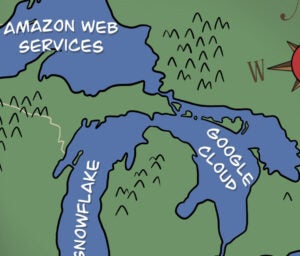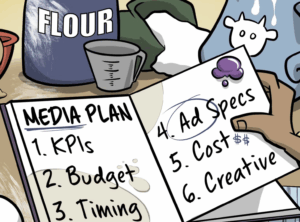 “Data Driven Thinking” is written by members of the media community and contains fresh ideas on the digital revolution in media.
“Data Driven Thinking” is written by members of the media community and contains fresh ideas on the digital revolution in media.
Today’s column is written by Chris O’Hara, Chief Revenue Officer at NextMark.
Worthless. That’s what I – and most of my colleagues – thought of leftover or remnant advertising when I was selling highly premium banner ad inventory to major advertisers a decade ago. At my workplace, we focused on sponsorships, advertorials, homepage, and index page banner ads. Today, much of this “transactional RFP” activity can be automated by programmatic-direct technologies via companies such as NextMark, Centro, isocket, and Adslot, not to mention Mediaocean. But back then, we were selling our entire premium inventory – mostly 728×90 pixel and 300×250 pixel banners targeting high-spending B2B readers – by hand for CPMs upwards of $50, compared to perhaps the high teens today.
In that market, remnant advertising was barely an afterthought. To fill most of the below-the-fold and deep-paged inventory, we ran house ads or bundled “value added” run-of-site impressions together for our good customers. Those were simple days, when the key to making money was thought to be selling more and pushing your editorial team to produce more content worthy of high-CPM banner placements.
Publishers’ approach to remnant inventory sure has changed since then. About five years ago, they found some ad-tech folks to take 100% of it off their hands. Even though they didn’t get a lot of money for it, these deals left publishers open to focus on their premium inventory and sales relationships. In doing some of those early network deals, I wondered who the hell would want millions of below-the-fold banners and 468x90s anyway. Boy, was I stupid. Close your eyes for a year or two and a whole “Kawaja map” pops up.
We all know what happened next: Networks used data and technology to make the crap they were buying more relevant to advertisers (through “audience targeting”), and buyers – which were seeing CPMs drop from $17 to $7 – played right along. Advertisers love programmatic Real-Time Bidding buying (RTB), for obvious reasons. It puts them in the driver’s seat, lets them determine pricing, and also (thanks to “trading desks”) lets some agencies enhance their shrinking margins with a media vigorish.
But publishers love it less. The same audience-targeting capability that lifted agency and ad-tech margins was sinking theirs. Publishers were seeing CPMs decline, networks eat into overall ad spending, demand-side platforms further devaluing inventory, and self-service platforms like Facebook siphon off more of the pie. This trend is, ultimately, unsustainable.
How do publishers regain control of their remnant inventory and start to take their rightful ownership of audience targeting? The answer turns out to be simple, although it involves some painful tech implementation to get tag, CRM, and sales data aligned. Data-Management Platforms (DMPs) are a publisher’s best friend.
These platforms are the key to helping publishers segment, target, and expand their audiences via look-alike modeling. They can leverage both publishers’ own data and their clients’ first-party data to drive powerful audience-targeted campaigns right within their own domains. This, in turn, enables them to start capturing real CPMs for their inventory rather than handing networks and sell-side platforms the lion’s share of advertising dollars. Any publisher with a significant amount of under-monetized inventory (along with the organizational fortitude to embrace technology and change, and a decent-sized budget) would be foolish to fail to take advantage of these benefits.
Lotame, a DMP company, shut down its ad network precisely because it saw this need and opportunity coming. Now it helps publishers power their own inventory and take back control. For publishers, understanding your audience – and having the data to help your advertisers understand it – is critical. About a dozen DMPs are already available that are highly effective at audience activation.
Growing Publisher Revenue
AdExchanger Daily
Get our editors’ roundup delivered to your inbox every weekday.
Daily Roundup
Beyond helping publishers understand their audiences better, though, the real value of DMPs is that they can also enable publishers to launch their own type of “trading desks.” Before we start talking about “PTDs” or “PTSDs,” however, let me explain what I mean.
Imagine that I am BigSportsSite, for example, the world’s foremost expert in sports content. I rank No. 1 or No. 2 in comScore for my category and consistently sell my inventory at a premium. What happens when I have only $800,000 in “basketball enthusiasts” in a given month and my advertiser needs $1 million worth? Today, that agency would likely end up buying every last scrap of premium inventory it can find on my site and others, then would hand over the remaining budget to an agency trading desk, which would use MediaMath to find “basketball intenders” and other likely males across a wide range of exchange inventory.
But I, BigSportsSite, know more about this particular audience than anyone else. I have the historical campaign data, access to mountains of first-party site data and access to my clients’ first-party data. I’m the one with the content expertise to know what types of pages and context perform well for various types of creative material, and – by the way – I already license content to a larger network of pre-qualified, premium sites that also reach a similar audience. So doesn’t it make sense for BigSportsSite to run a trading desk, doing reach extension on their advertisers’ behalf?
The reason sites such as the imaginary BigSportsSite haven’t done this so far is 1) they haven’t before had access to the right set of tools, and 2) as a notion, “audience discovery” has thus far remained squarely in the demand side’s wheelhouse. I think that’s a huge mistake. If I were a publisher who frequently runs out of category-specific inventory – such as “sports lovers” – I would immediately install a DMP and hire someone to help me monetize the last $200,000 of an RFP. Advertisers would certainly trust BigSportsSite to be the authority on its audience, and, just as importantly, to be the arbiter of what constitutes high-quality category content.
Why let the demand side have all of the fun? Publishers who understand their audience can find them on their own site, on their clients’ sites, across an affiliated network of partner sites and in the long tail through exchanges. Meanwhile, advertisers and agencies could benefit from buying multi-tiered audience packages – aligned with their ongoing sponsorship and transactional premium direct advertising – through a single trusted partner.
To help bring back a more balanced industry, publishers need to find ways to make money from audience targeting. So whether they end being called publisher trading desks or – I hope – something else, every good publisher should have one.
Follow Chris O’Hara (@chrisohara) and AdExchanger (@adexchanger) on Twitter.













